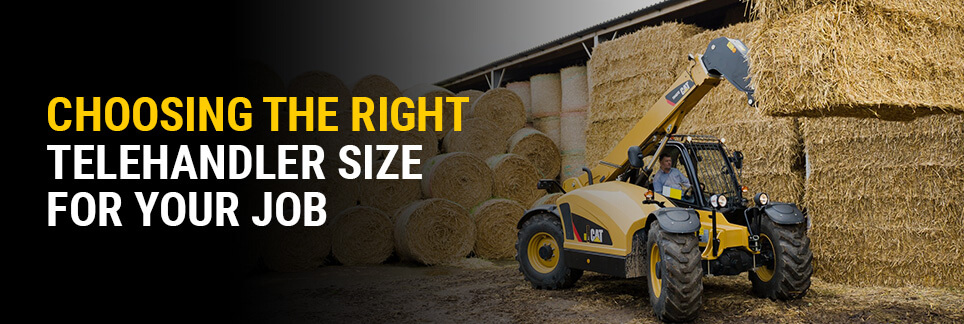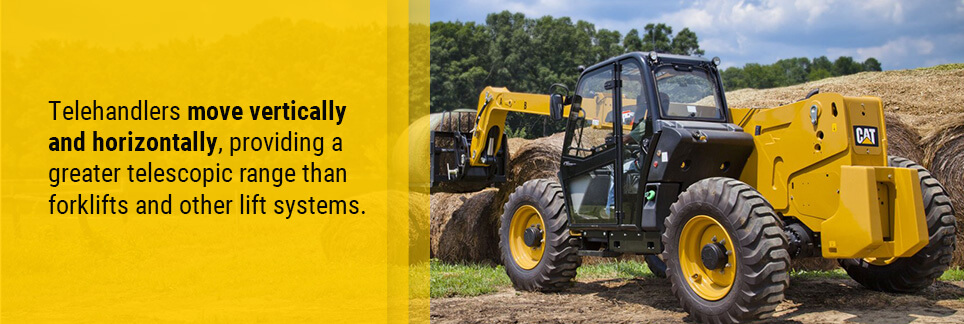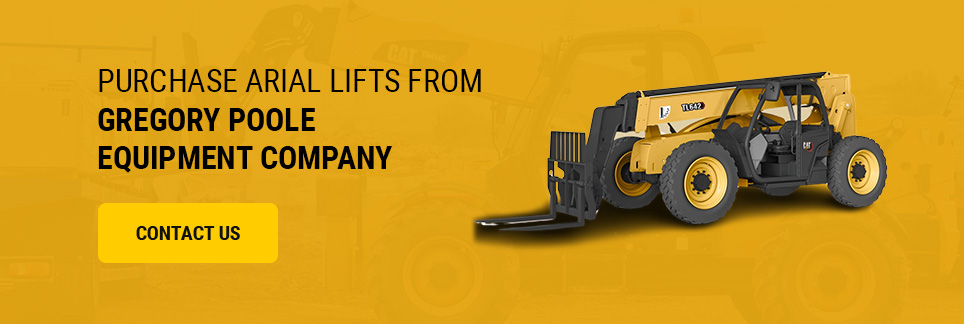
So, you’ve decided you need a telehandler, but how do you know what size telehandler to use? When going through your options, it’s easy to get overwhelmed. Whether you’re in construction, masonry, landscaping, agriculture or another field of work, having the right equipment can make all the difference in your productivity and efficiency.
This guide offers all the information you need to choose a telehandler size that works for you.
Telehandlers are a specific type of aerial boom lift, named for their telescopic arm. Like forklifts, they lift loads, but a telehandler’s extendable boom means it can move loads higher and further away than a forklift. You’ll also find a greater variety of choices when it comes to boom attachments for telehandlers, making them an incredibly versatile machine.
When looking for telehandlers, it’s important to examine and fully understand the different variables on the manufacturer’s load chart. The machine’s load chart will detail exactly how much weight the telehandler can accommodate at different boom angles and heights. Referencing the load chart and staying within the outlined limits ensures you remain within safe operating parameters.
The telehandler’s model number can also give you an idea of its maximum weight and height capacity. For example, the Genie® GTH™-1056 has a maximum weight capacity of 10,000 pounds and a maximum lift height of 56 feet, reflected in its model number.
This equipment comes in a wide variety of configurations, which is partly why choosing a telehandler size can be so difficult.
In terms of machine size, there are two basic classifications:
Another class of telehandlers you’ll see is fixed vs. rotating telehandlers:
To get the right size telehandler for your needs, use the following considerations as you evaluate your options:
The weight your telehandler can accommodate, as indicated in the load chart, will be one of the most important factors in determining the size telehandler you need. Smaller, compact telehandlers tend to have lower maximum weight capacities compared to their full-size counterparts.
For example, the Genie® GTH™-5519 is a compact telehandler that has a maximum lift capacity of 5,500 pounds. However, this capacity decreases to 4,400 pounds when the boom is extended to its maximum height, and further lowers to 1,900 pounds at its maximum reach.
It’s usually easy to tell whether you need a higher weight capacity. If your standard job site is small and you don’t frequently need extra heavy loads, you may be better off with a compact option. The time you save with the ease of maneuvering the compact telehandler will more than make up for breaking up your heavier loads.
Another factor to consider when determining your telehandler’s load capacity is the weight of any attachments you plan to use. You’ll need to account for both the attachment and the load to pick the right size.
Telehandlers move vertically and horizontally, providing a greater telescopic range than forklifts and other lift systems. When looking for a telehandler, consider how high up your job tasks will require you to reach. Construction applications will benefit from greater height and reach capacities, while certain landscaping applications may not require as much.
How high and far the boom reaches also affects the machine’s stability. Higher and longer lifts won’t pose a problem for normal applications on level ground. However, if you work with unstable ground conditions, you should pay close attention to the load capacity at the greatest height and reach to ensure your machine remains stable as you use it.

Telehandlers, no matter the size, are heavy pieces of machinery. Tip-overs and other accidents can have a big impact on job site safety and productivity. If your jobs are often on rough, uneven terrain, a large telehandler with four-wheel drive can offer greater stability. In contrast, smaller telehandlers work better for navigating smaller job sites in more confined spaces.
Think about the conditions you’re up against when you’re working — are you out in the elements or indoors? On gravel or compacted dirt surfaces? Do you need to be able to navigate around machinery, equipment or shelving? Take your answers to these questions into account when choosing a telehandler.
Your budget may also determine what size telehandler you ultimately purchase. Aspects like size, capacity and features will influence the final cost, as well as your financing terms. Be sure to remember insurance, maintenance and transportation in your cost budgeting when purchasing a telehandler.
Used options may also be available at a slightly lower price. Be sure to buy from a trusted dealer that keeps detailed maintenance and service records.
If purchasing a machine outright is out of reach for you, or you want to try different equipment before deciding, you can also rent a telehandler. This option gives you a dependable machine you can use for a specific job, without the commitment and maintenance obligations of ownership.
Because telehandlers are heavy equipment with many considerations for safe operation, OSHA requires special certification for these Class VII variable reach machines. Accidents can pose health and safety risks to your workers and impact productivity, company reputation and your bottom line.
Telehandler size can play a role in the operation of the equipment. Taking an operator safety training course that meets all of OSHA’s standards is key for anyone who will be operating the telehandler.
When choosing the right size telehandler for your application, you need to be able to trust the company you’re working with. Gregory Poole has over 70 years of experience in the industry, and we’re staffed with a highly knowledgeable technical team who can answer any questions you have about the best machine purchase.
We have 13 locations across eastern North Carolina and a dedicated parts and service team that can keep your equipment in top form for years to come. Shop our available telehandlers or contact a representative to get a quote or ask questions about our machines!
